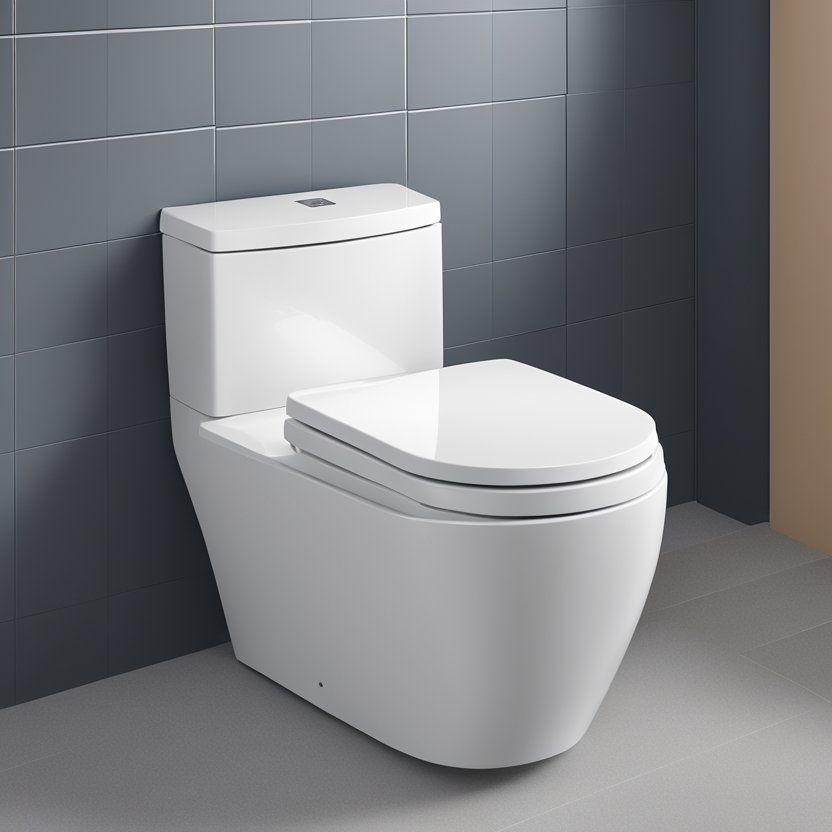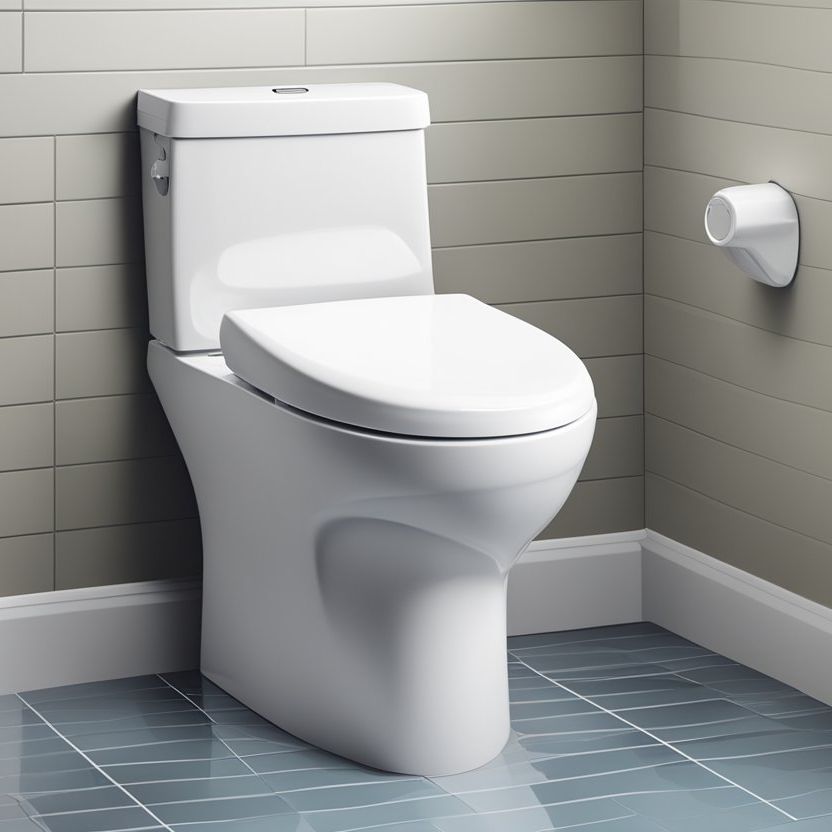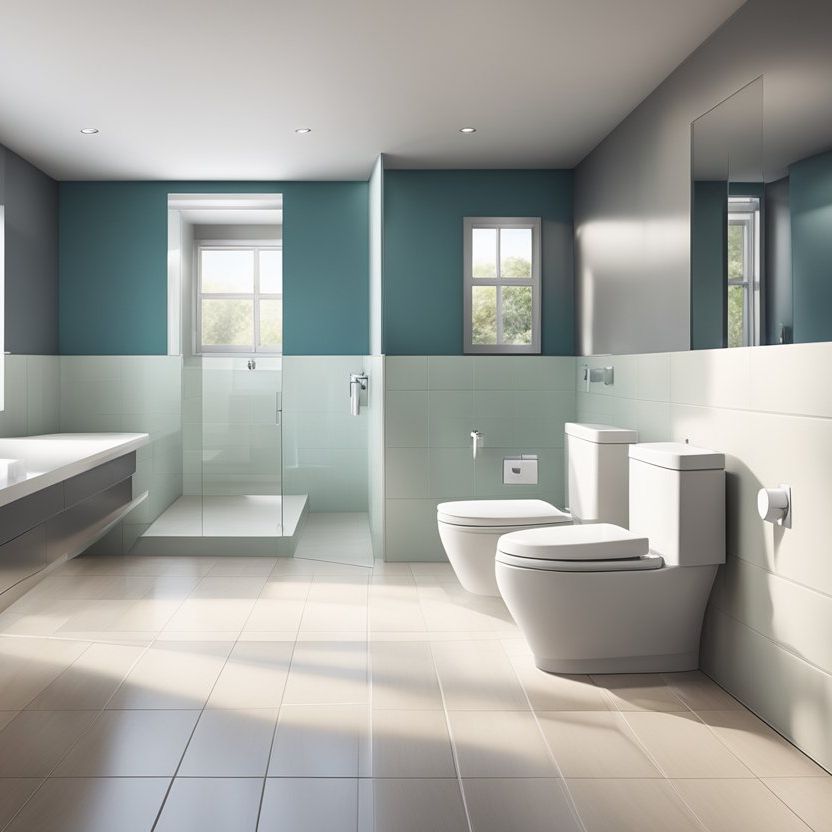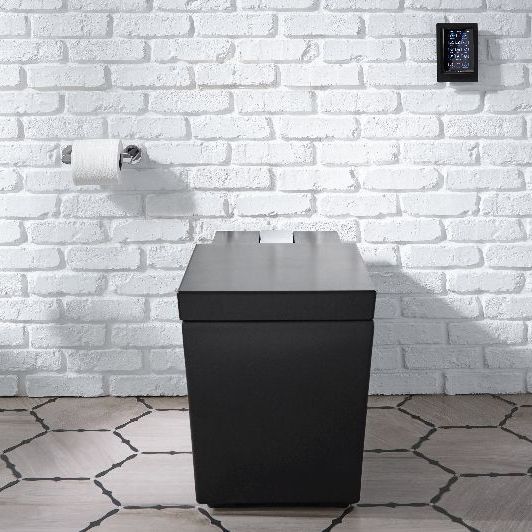 Spanish
Spanish
Jabra Sanitary, una fábrica profesional de artículos sanitarios, ofrece productos cerámicos económicos. Buscamos distribuidores, mayoristas y contratistas. ¡Solicite información ahora!
 Precios directos de fábrica
Precios directos de fábrica Bajo pedido mínimo (MOQ)
Bajo pedido mínimo (MOQ) Más de 20 años de experiencia en la industria
Más de 20 años de experiencia en la industria
If you've avoided investing in a high-efficiency toilet due to experiences with weak, low-flow public restroom toilets, it's time to reconsider.
Modern high-efficiency toilets, unlike those low-power models, offer powerful flushing without multiple attempts. For an environmentally friendly option without compromising performance, a high-efficiency toilet is an excellent investment.
High-efficiency toilets vs regular, what one to choose? This guide will help you understand the differences and make an informed choice.

Table of Contents
What is a High Efficiency Toilet
High Efficiency Toilets vs Regular
Types of High-Efficiency Toilets
Policy and Regulation Impact of Efficient Toilets
How to Choose the Most Efficient Toilets
Innovations in Toilet Efficiency: Smart Toilets
Frequently Asked Questions
Conclusion
When you retrofit your bathrooms with efficient toilets today, you won't encounter the disappointing experiences associated with early LEED-certified buildings from the late 1990s and early 2000s.
Thanks to the EPA's standards and new technology, modern high-efficiency toilets (HETs) and ultra-high-efficiency toilets (UHETs) now outperform traditional toilets in efficiency, lifespan, and power.
WaterSense-rated high efficiency flush toilets, certified by the EPA, use about 1.28 gallons per flush and maintain the expected flushing experience. By switching to a high-efficiency design today, you can avoid issues like multiple flushes and low-flow cleaning problems.
The blue and green WaterSense label identifies toilets that meet the latest standards for performance and efficiency. This eco-friendly option has become so prevalent today that most homeowners now see it as the only choice for replacing an existing toilet.
High Efficiency Toilets vs Regular
1. Water Usage and Water Efficiency
Regular Toilets
Regular toilets, often referred to as standard toilets, typically use about 3.5 to 5 gallons of water per flush (GPF). Older models, especially those installed before the 1990s, can use up to 7 GPF.
High-Efficiency Toilets
High-efficiency toilets are designed to use less water without compromising performance.
- HETs: About 1.28 gpf or less
- UHETs: Less than 1.28 gpf
Under U.S. Federal law, new toilets must use no more than 1.6 gallons per flush (gpf). High-efficiency toilets (HETs) exceed this standard, using only 1.28 gpf, which is a 20% savings (6 liters vs. 4.8 liters).
Ultra high efficiency toilets can further reduce water use to less than 1.1 GPF. This distinction in water consumption translates into significant savings on utility bills and is more environmentally friendly.
By implementing a dual-flush mechanism, users can choose between a low flush toilet for liquid waste and a standard-volume flush for solid waste. This flexibility in flushing options allows for more precise water use without compromising performance.
In terms of flush effectiveness, traditional toilets relied on more water to clear waste. However, modern high performance toilets are designed with advanced flush technology to make each flush count—delivering equal or superior performance while using less water.
Energy Efficient Toilets Comparison and Potential Water Savings
- According to the Environmental Protection Agency, switching to high-efficiency toilets can cut a home's toilet water usage by more than 50%.
- A family of four can save $2,000 over the lifespan of a high-efficiency toilet, according to the EPA. That's a savings of 4,000 gallons of water per year without any change in bathroom experience.
2. Performance and Flush Mechanisms
Flushing Mechanisms in Regular Toilets
Regular toilets primarily use gravity-fed flush systems, which rely on water weight to clear waste. They can sometimes require multiple flushes, increasing water usage. Some models use a siphon action to dispose of waste.
Flushing Mechanisms in High-Efficiency Toilets
HETs use advanced flushing technologies such as pressure-assist and dual-flush systems:
- Pressure-assist: Uses pressurized air to enhance flushing power.
- Dual-flush: Offers two flush options, a low-volume flush for liquid waste and a higher-volume flush for solid waste.
3. Cost Efficiency
Initial Cost Comparison
- Regular toilets: $100 - $300
- High-efficiency toilets: $200 - $500
HETs and UHETs can be more expensive upfront.
Long-Term Cost Savings with HETs
- Reduced water bills due to lower water usage.
- Potential rebates and incentives from local utilities for installing HETs.
Return on Investment
- Initial higher cost of HETs can be offset within a few years through water bill savings.
- Rebates can further reduce the upfront investment.
4. Environmental Impact
Water Conservation Benefits
- HETs significantly reduce household water consumption.
- Contributes to the preservation of local water resources.
Environmental Footprint of Manufacturing
- Some HETs are made from recycled materials, reducing their environmental footprint.
- Consideration of the manufacturing process and materials used is essential.
Impact on Sewage Systems
- Reduced water usage alleviates pressure on sewage and wastewater treatment systems.
- Decreased risk of sewage overflows and water contamination.
So, are high-efficiency toilets worth the investment? Absolutely, as they benefit both your water bill and the overall health of our environment.
It's important to consider these differences when purchasing a toilet. If you decide to choose the best high efficiency toilet, explore Jabra Sanitary toilet collections.
5. User Experience
Comfort and Usability
- Modern HETs are designed with user comfort in mind, featuring ergonomic designs.
- Taller bowls and elongated seats are common in HETs for improved comfort.
Noise Levels
- Pressure-assist HETs can be louder than regular toilets.
- Gravity-fed HETs are typically quieter and more similar to regular toilets in noise levels.
Maintenance Requirements
- HETs may require occasional maintenance of advanced flushing mechanisms.
- Overall maintenance needs are similar to regular toilets.

Types of High-Efficiency Toilets
With advancements in technology, manufacturers offer various flushing systems catering to different preferences and requirements.
Single-flush Toilets
Single-flush toilets are a common type of HET that uses a fixed volume of water—typically around 1.28 gallons per flush (GPF) or less.
They are WaterSense certified, ensuring water conservation while maintaining adequate flush power. These toilets are a straightforward choice for those seeking consistent performance with every flush.
Dual-flush Toilets
Dual-flush toilets provide two flushing options: a partial flush for liquid waste and a full flush for solid waste.
The partial flush usually uses around 0.8 GPF, while the full flush remains efficient at approximately 1.6 GPF or less. This system gives users the flexibility to manage water usage depending on the type of waste, leading to significant water savings over time.
Pressure-assist Toilets
Pressure-assist toilets utilize pressurized air to boost the flushing efficacy. They typically use about 1.0 to 1.28 GPF, making them highly efficient in clearing the bowl in one flush.
These toilets are well-suited for busy or public bathrooms where powerful, reliable flushing is necessary.
Policy and Regulation Impact of Efficient Toilets
In the United States, the Energy Policy Act of 1992 standardized that all new toilets sold must use no more than 1.6 gallons per flush (gpf).
Subsequently, innovations have led to the introduction of High-Efficiency Toilets (HETs) which use a maximum of 1.28 gpf, and Ultra-High-Efficiency Toilets (UHETs) which use even less.
The Environmental Protection Agency (EPA) further encourages water efficiency through its WaterSense program, marking products that meet high performance and efficiency criteria.
Toilets bearing the WaterSense label are independently certified to use 1.28 gpf or less, providing at least 20% water savings over the federal standard.
Here's how these regulations and policies impact the market and usage:
- Incentivization: Many local utilities offer rebates to encourage the installation of efficient toilets.
- Standardization: Setting a federal standard for toilet flush volumes ensures a baseline for water efficiency.
- Consumer Awareness: Labeling systems inform buyers, fostering an educated market that prioritizes sustainability.
How to Choose the Most Efficient Toilets
In selecting the most efficient toilets for both residential and commercial settings, it's crucial to assess specific criteria to ensure optimal performance and water savings.
Certification
Look for the EPA's WaterSense certification, ensuring the models do not exceed the 1.28 GPF mark.
Effectiveness
Effectiveness is measured by the toilet's ability to clear waste in a single flush — an essential factor for user satisfaction.
To measure this, look for third-party testing results or certifications indicating superior flush performance.
Other Considerations
Beyond water usage and flush effectiveness, consider factors such as noise level, aesthetic design, ease of cleaning, and cost of operation.
Features like dual-flush technology provide options for liquid or solid waste, further conserving water.
The ease of installation and compatibility with existing plumbing is also pivotal for a seamless transition to more efficient toilets.

When sourcing water efficient toilets for wholesale, it's essential to partner with reputable manufacturers that align with efficiency standards and market demands.
Famous Brand: Toto, Kohler
- Toto: Recognized globally, Toto offers a range of ultra-high-efficiency toilets that meet rigorous WaterSense certifications.
- Kohler: A household name, Kohler is known for its diversity in high-efficiency toilets, combining water-saving technology with contemporary design.
- Caroma: An Australian brand noted for water efficiency, Caroma presents a variety of dual-flush options recognized for their flush effectiveness.
- HCG: High-quality Asian manufacturing comes standard with HCG, offering efficient toilets that fit well into various market segments.
- Jabra Sanitary: This Chinese toilet manufacturer provides competitive pricing on high-efficiency toilets, appealing to wholesalers seeking cost-effective solutions without sacrificing performance.
Innovations in Toilet Efficiency: Smart Toilets
Recent advancements in toilet technology have led to the development of smart toilets.
- Dual-Flush Capability: Many smart toilets incorporate dual-flush mechanisms that allow users to select the volume of water per flush—usually an ultra-low 1-gallon option for liquid waste and a higher volume for solid waste.
- Self-cleaning Technology: An impressive aspect of smart toilets is their self-cleaning function. Some models utilize UV light and electrolyzed water, which can clean and sanitize the toilet bowl without the need for harsh chemicals.
- EPA's WaterSense Certification: The best-performing high-efficiency toilets carry the WaterSense certification.
- Advanced Features: Equip with features like heated seating, automated lids, and bidet functions. These contribute to a hygienic and comfortable experience while maintaining efficient water use.
- Water Efficiency Ratings: Rated based on their flush effectiveness and water usage, providing clear measurement of their eco-friendly impact.
Smart toilets are setting a new standard for the bathroom experience, prioritizing water efficiency and user convenience. These innovations reflect a commitment to eco-friendly practices and the evolution of home technology.
Frequently Asked Questions
Are High-Efficiency Toilets Worth It?
Yes, high-efficiency toilets are worth it. They save water and money, perform well with modern technology, and contribute to environmental sustainability.
Everyone worries about the performance of low-flow toilets. Do they effectively clear the bowl and keep it clean? Do they clog frequently?
Unlike the initial 1.6 gpf models, WaterSense high-efficiency toilets (HETs) combine high efficiency with superior performance. Advances in toilet design allow WaterSense HETs to conserve water without sacrificing flushing power.
In fact, many HETs outperform standard toilets, thanks to computer-aided design rather than the trial-and-error approach of earlier models.

How Do Water-Saving Toilets Work?
The National Energy Policy Act of 1995 mandated that all new toilets must be low-flow, using no more than 1.6 gallons per flush. Initially, kits were added to existing toilets, but they were often ineffective. Now, various low-flow toilet designs are available. Curtis Plumbing can help you choose the best option for your home or office:
- Two-button flush: Offers 0.8 gallons per flush for liquids and a full flush for solids, providing water-saving options.
- Gravity-fed tank: The most common and usually the least expensive, these flush based on water weight and volume.
- Pressure-assisted: Uses pressurized air to flush, with no water in the bowl until needed; these are more expensive and louder.
Look for the WaterSense label to ensure high efficiency and cost savings. Smart toilets with features like automatic flushing and Bluetooth capability are also available.
Does Low-flow = Poor performance?
No, low-flow does not mean poor performance. Modern high-efficiency toilets (HETs) are designed to provide powerful flushing while using less water. Advances in technology have made these toilets more effective than older models.
Do high-efficiency toilets cause problems with home plumbing systems?
High-efficiency toilets are designed to work with standard plumbing systems. In most cases, they do not cause any issues. However, in older homes with outdated plumbing, some adjustments may be needed to ensure optimal performance.
Aren't high-efficiency toilets too expensive?
While the initial cost of high-efficiency toilets may be higher, the long-term savings on water bills and potential rebates can offset the initial investment. They are a cost-effective choice over time.
High-efficiency toilets are not available in the style I want?
High-efficiency toilets come in a wide variety of styles and designs. Whether you prefer a sleek modern look or a more traditional style, there are some new models like 802 available to suit your preferences.
Conclusion
If you're renovating your home, dealing with issues with your current toilet, or seeking a more eco-friendly option, consider opting for a WaterSense rated, high-efficiency toilet.
High-efficiency toilets offer significant water savings, potential cost benefits, and positive environmental impact, making them a suitable choice for environmentally conscious consumers and those looking to reduce utility bills.





















